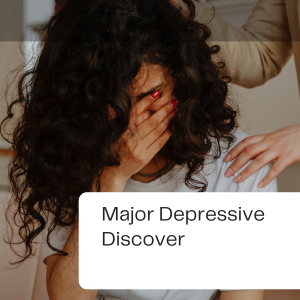
Overview
Major Depressive disorder (depression) is a prevalent mental illness. It is characterized by a low mood or a lack of pleasure or interest in activities over an extended length of time.
Depression differs from normal mood swings and sentiments about daily living. It may have an impact on every part of life, including connections with family, friends, and the community. It may result in or contribute to troubles in school and job.
Depression may affect anybody. People who have experienced abuse, catastrophic losses, or other traumatic experiences are more prone to become depressed. Women are more prone to experience depression than males.
Depression affects an estimated 3.8% of the population, including 5% of adults (4% male and 6% female) and 5.7% of persons over the age of 60. Approximately 280 million individuals worldwide suffer from depression (1). Depression is about 50% more frequent in women than in males. More than 10% of pregnant and postpartum women worldwide suffer from depression (2). Each year, more than 700,000 individuals die by suicide. Suicide is the fourth highest cause of mortality among those aged 15 to 29 years.
Despite the fact that there are recognized and effective therapies for mental diseases, more than 75% of persons in low- and middle-income countries do not obtain therapy (3). Barriers to successful treatment include a lack of investment in mental health care, a scarcity of educated health-care workers, and the societal stigma associated with mental illnesses.
Symptoms and patterns
During a depressive episode, a person feels depressed (sad, impatient, empty). They may experience a lack of enjoyment or interest in some activities.
A depressed episode differs from normal mood changes. They last the most of the day, almost every day, for at least two weeks.
Other symptoms may include the following:
Poor concentration
Symptoms may include feelings of guilt or poor self-worth, despair about the future, suicidal ideation, interrupted sleep, changes in eating or weight, and fatigue.
Depression may create problems in many areas of life, including the community, the family, employment, and school.
A depressive episode is classified as mild, moderate, or severe based on the frequency and intensity of symptoms, as well as their influence on the individual’s functioning.
There are several patterns of depressed episodes, including:
There are three types of depression: single episode depressive disorder (first and only episode), recurrent depressive disorder (at least two episodes), and bipolar disorder (depressive episodes alternate with manic symptoms such as euphoria or irritability, increased activity or energy, and other symptoms such as increased talkativeness, racing thoughts, increased self-esteem, and decreased need for sleep).
Contributing Factors and Prevention
Depression is the outcome of a complex interplay of social, psychological, and biological variables. People who have had negative life experiences (unemployment, bereavement, traumatic incidents) are more prone to develop depression. Depression may lead to increased stress and dysfunction, worsening both the afflicted person’s living condition and the depression itself.
Depression is linked to and influenced by physical health. Many of the conditions that contribute to depression (such as physical inactivity or excessive alcohol use) are also established risk factors for cardiovascular disease, cancer, diabetes, and respiratory disorders. People suffering from these conditions may also experience depression as a result of the challenges involved in controlling their condition.
Prevention programs have been demonstrated to lessen depression. School-based programs that promote healthy coping in children and adolescents are effective community approaches to depression prevention. Interventions for parents of children with behavioral difficulties may lessen parental depressive feelings while also improving their children’s results. Exercise programs for the elderly may also be useful in depression prevention.
Diagnoses and treatments
There are effective therapies for depression. These include psychological therapy and medicines. If you are experiencing signs of depression, get help.
The primary line of therapy for depression is psychological. They may be used in conjunction with antidepressants for moderate-to-severe depression. Antidepressants are not required for moderate depression.
Psychological therapy may teach individuals new ways to think, cope, and interact with others. They may incorporate professional talk therapy as well as lay therapist supervision. Talk therapy may be conducted in person or online. Self-help manuals, websites, and apps provide access to psychological therapy.
The following are examples of effective psychological therapies for depression:
Behavioral activation
Cognitive-behavioral therapy
Interpersonal psychotherapy and problem-solving therapy.
Antidepressant drugs include selective serotonin reuptake inhibitors (SSRIs), like fluoxetine.
Healthcare professionals should consider the potential side effects of antidepressant medication, their capacity to give either intervention (in terms of skill and/or treatment availability), and their patients’ choices.
Antidepressants should not be used to treat depression in children, and they should not be used as the first line of therapy in teenagers.
Bipolar illness is managed with a variety of drugs and therapies.
Self-care
Self-care may help manage depressive symptoms and promote overall well-being.
What You Can Do:
To manage depression, it’s important to engage in activities you like, remain connected with friends and family, exercise frequently (even if it’s only a short walk), maintain normal eating and sleeping patterns, and limit alcohol and illicit drug use.
Tell someone you trust about your emotions.
Seek assistance from a healthcare practitioner.
If you have thoughts of suicide:
Remember you are not alone and that many others have received assistance. Reach out to someone you trust, see a health provider, or join a support group.
If you believe you are in urgent risk of injuring yourself, call any available emergency services or a crisis line.
WHO reaction
The World Health Organization’s Mental Health Action Plan 2013-2030 outlines the actions necessary to offer effective therapies for persons suffering from mental diseases, including depression.
Depression and self-harm/suicide are among the priority conditions addressed by WHO’s Mental Health Gap Action Programme. The Programme’s goal is to assist nations in expanding services for persons suffering from mental, neurological, and drug use problems via treatment delivered by non-mental health professionals.
WHO has created short psychological intervention guides for depression that lay therapists may give to individuals and groups. One example is the Problem Management Plus (PM+) handbook, which explains the use of behavioral activation, stress management, problem-solving therapy, and social support strengthening. Furthermore, the Group interpersonal therapy for depression handbook covers group treatment for depression. Finally, the Thinking Healthy Manual discusses the use of cognitive-behavioral treatment for perinatal depression.







